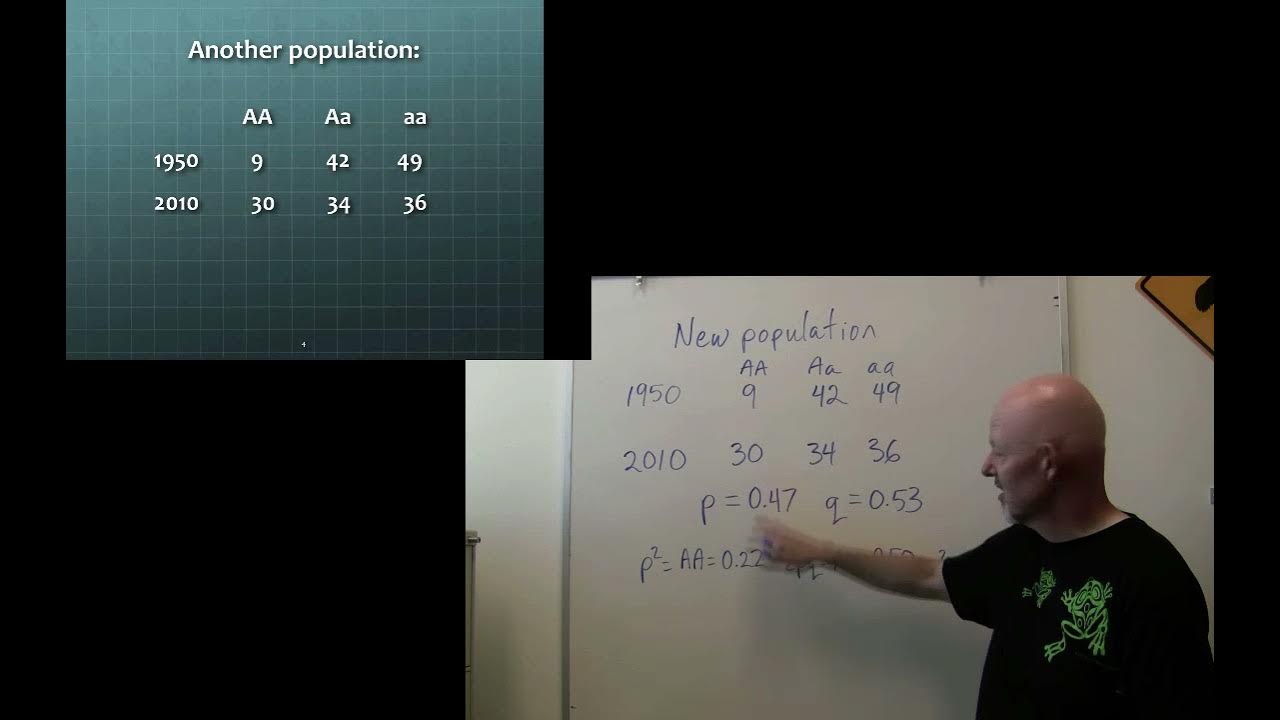Hardy-Weinberg Equilibrium
Summary
TLDRThis script delves into the intersection of biology and mathematics, specifically the Hardy-Weinberg Equilibrium, which posits that allele and genotype frequencies in a population remain constant unless influenced by evolutionary forces. It clarifies misconceptions about the prevalence of math in biology, outlines the five assumptions necessary for the equilibrium to hold, and provides a step-by-step guide to calculating allele and genotype frequencies using the Hardy-Weinberg equations. The script emphasizes the practical application of this theoretical framework in understanding evolutionary changes in populations.
Takeaways
- 🧩 Biology and math are intertwined, with various biological processes involving mathematical calculations.
- 🔍 The Hardy-Weinberg Equilibrium is a concept that combines biology and math, illustrating the balance of allele and genotype frequencies in a population.
- 🌐 Named after a mathematician and a physician, the Hardy-Weinberg Equilibrium states that allele and genotype frequencies remain constant in a population unless affected by evolutionary forces.
- 🐸 The concept is exemplified using a simplified model of frogs with different colors due to different genotypes (GG, Gg, gg).
- 📊 To be in Hardy-Weinberg equilibrium, five assumptions must be met: no selection, no mutation, no migration, a large population, and random mating.
- ⚠️ Hardy-Weinberg Equilibrium is often not observed in nature due to various evolutionary pressures, such as predators affecting the survival of certain phenotypes.
- 📐 The Hardy-Weinberg Equilibrium provides a mathematical baseline to compare evolving populations against stable ones without evolutionary influences.
- 📘 Two key equations represent the Hardy-Weinberg Equilibrium: p + q = 1 for allele frequencies, and p^2 + 2pq + q^2 = 1 for genotype frequencies.
- 🔢 The example given uses allele frequencies (p=0.6, q=0.4) to calculate genotype frequencies, demonstrating the application of the Hardy-Weinberg principles.
- 📝 When solving Hardy-Weinberg problems, it's crucial not to assume genotypes from phenotypes without clear evidence, as multiple genotypes can produce the same phenotype.
- 🔄 Practice is essential for mastering the calculations and applications of the Hardy-Weinberg Equilibrium, with many resources available for further learning.
Q & A
What is the common misconception about math in biology when people first start studying it?
-The common misconception is that there is no math in biology, but they soon find out that math is involved in various biological processes and calculations.
What is the Hardy-Weinberg Equilibrium and why is it significant in biology?
-The Hardy-Weinberg Equilibrium is a principle that states that a population's allele and genotype frequencies remain constant unless an evolutionary force acts upon them. It's significant because it provides a baseline to compare how an evolving population differs from one that remains constant without evolutionary forces.
What are the five assumptions required for a population to be in Hardy-Weinberg Equilibrium?
-The five assumptions are: 1) No selection, 2) No mutation, 3) No migration, 4) Large population, and 5) Random mating.
How do allele frequencies add up in a population according to the Hardy-Weinberg Equilibrium?
-Allele frequencies in a population must add up to 1, ensuring that the total contribution of all alleles is complete.
What does the equation p + q = 1 represent in the context of the Hardy-Weinberg Equilibrium?
-The equation p + q = 1 represents the sum of the frequencies of the dominant allele (p) and the recessive allele (q) in a population, which must equal 1.
What does the equation p^2 + 2pq + q^2 = 1 signify in the Hardy-Weinberg Equilibrium?
-This equation represents the genotype frequencies in a population, where p^2 is the frequency of homozygous dominant (GG), 2pq is the frequency of heterozygous (Gg), and q^2 is the frequency of homozygous recessive (gg).
Why is it incorrect to assume that the dominant allele frequency (p) must be larger than the recessive allele frequency (q) in a population?
-It's incorrect because the dominant allele isn't always more common in a population. The Hardy-Weinberg Equilibrium does not imply that p must be greater than q; it only requires that their sum equals 1.
How can you determine the allele frequencies from the genotype frequencies in a population?
-You can determine the allele frequencies by using the Hardy-Weinberg Equilibrium equations. For example, knowing the homozygous recessive frequency (q^2) allows you to calculate q by taking the square root, and subsequently, p can be found using p + q = 1.
What is the significance of practicing Hardy-Weinberg Equilibrium problems?
-Practicing helps in understanding the application of the Hardy-Weinberg Equilibrium in analyzing and comparing the extent of evolutionary forces acting on a population, providing a baseline for comparison.
Why is it important to check that the calculated values in the Hardy-Weinberg Equilibrium equations sum up to 1?
-Checking that the values sum up to 1 ensures the accuracy of the calculations and confirms that the allele and genotype frequencies are correctly represented according to the Hardy-Weinberg Equilibrium.
How can the Hardy-Weinberg Equilibrium be used to identify deviations from a stable genetic population?
-By comparing the calculated genotype and allele frequencies with the expected values under Hardy-Weinberg Equilibrium, one can identify deviations that may indicate the presence of evolutionary forces such as selection, mutation, migration, or genetic drift.
Outlines

Dieser Bereich ist nur für Premium-Benutzer verfügbar. Bitte führen Sie ein Upgrade durch, um auf diesen Abschnitt zuzugreifen.
Upgrade durchführenMindmap

Dieser Bereich ist nur für Premium-Benutzer verfügbar. Bitte führen Sie ein Upgrade durch, um auf diesen Abschnitt zuzugreifen.
Upgrade durchführenKeywords

Dieser Bereich ist nur für Premium-Benutzer verfügbar. Bitte führen Sie ein Upgrade durch, um auf diesen Abschnitt zuzugreifen.
Upgrade durchführenHighlights

Dieser Bereich ist nur für Premium-Benutzer verfügbar. Bitte führen Sie ein Upgrade durch, um auf diesen Abschnitt zuzugreifen.
Upgrade durchführenTranscripts

Dieser Bereich ist nur für Premium-Benutzer verfügbar. Bitte führen Sie ein Upgrade durch, um auf diesen Abschnitt zuzugreifen.
Upgrade durchführenWeitere ähnliche Videos ansehen
5.0 / 5 (0 votes)






